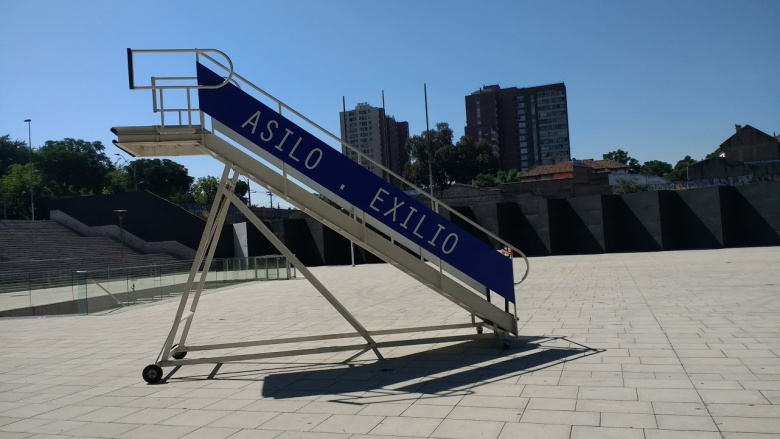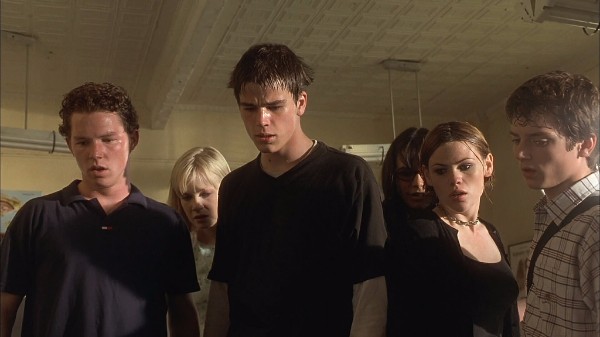In English:
The Museo de la Memoria y Derechos Humanos has created a project entitled Memorias del Exilio in order to give voice to the experiences of Chilean exiles. I am very moved and grateful to have had my story included in this archive. Recently I visited the museum. I went alone, as I wanted to get out-and-about by myself in the huge and beautiful city that is Santiago. It was a scorching day and I set off with a bottle of water in my wee leather bag, lots of enthusiasm and a general idea of its location. I got on the metro and for some reason I did not get a connecting train, maybe I saw a sign for Matucana and instead got off at Estación Central – the wrong stop. I asked a long-haired man who sold handcrafts on a street stall for directions. He seemed to be pleased I was going there and told me it was ‘quite a few’ cuadras (blocks) away and that I’d be better off taking a colectivo (communal taxi) on the other side of the road, otherwise the camino would entail a long straight walk of many blocks in the burning heat.
Having recently arrived from a Scottish winter and craving sunshine, I decided to take the scenic route all the way up Matucana St. After all it was just a few blocks! So … seven or so blocks later (I lost count), and red as a tomato, I came across the museum! There it was! Right opposite the Quinta Normal Park. The building itself was a sight to behold! The vast space and impressive architecture gave you a sense of awe, commanding instant humility and respect. The first display I saw, as I headed for the main doors, was of an aircraft boarding stairs replica, with the words ‘ASILO. EXILIO’ printed in huge white letters on its side. I stared at it and felt a little twitch in my stomach, like a little punch, which made me exhale through my nose.
The display took me back to the day we left Chile all those years ago, when as a lanky kid I had had to climb the real stairs up to a plane for the first time. The sun shone brightly that day too, as I turned around on the top step and looked out toward the mirador of what was then Pudahuel[1] International Airport. My eyes scanned the airport terrace for a glimpse of my dad, my gran or friends but all I saw was the building and the glare of the sun. Perched on that final step, facing the airport, still and speechless, I heard my mother encouraging me to wave goodbye as she walked up the stairs towards me.
These snippets of memory triggered tears which came and went freely during the whole visit and which often blurred my vision when trying to read labels or articles once inside. It was impossible to hide the tears. I noticed I wasn’t the only one crying. The testimonies, vinyls of the New Song Movement, photographs, posters and films resonated intensely with me. I felt deeply affected yet strangely comforted. It was like hearing my parents talking to me…or like visiting my early childhood.
For the first time ever I was occupying this honorable space created to commemorate the victims of human rights abuses committed during the dictatorship years. In many ways I was witnessing my mum and dad’s history as well as the recent history of my people. The evidence was all there in a very tangible way. Immensely proud that my parents had always campaigned for Allende (every time) and that they had lived their lives according to their principles, I was overwhelmed by a strong sense of love for them, for all my compatriots and our President Allende. I left the museum with an unyielding feeling of love for my country, my people and comforted by the thought that I belong. That as the Illapu song Tres versos para una historia says, ‘soy parte de esta historia’, I am part of this story!
I said farewell with a strengthened belief that the creation of this museum is a fundamental part of a national process of healing, one we cannot do without. Memory must be preserved by all means and in all forms. There is a past – our parents – and a future – our children, and we must do this for them.

En español:
El Museo de la Memoria y Derechos Humanos ha creado un proyecto llamado Memorias del exilio con el objetivo de dar voz a las experiencias de los exiliados chilenos. Estoy muy conmovida y agradecida de que mi testimonio haya sido incluido en este archivo. Recientemente visité el museo. Fui sola, ya que quería salir a patiperrear por las mías en esa gran ciudad que es Santiago. Fue un día de extrema calor y aunque prácticamente caían patos asados, partí con una botella de agua en mi carterita de cuero, mucho entusiamo y una idea general de su ubicación. Me fui en metro y por alguna razón, quizás vi un letrero con la palabra Matucana en algún lugar, me bajé en Estación Central – la parada equivocada. Le pregunté cómo llegar a un hombre de pelo largo que vendía artesanías en un puesto de la calle. Él parecía estar contento que yo anduviera buscando ese sitio y me dijo que estaba ‘a bastante cuadras de distancia y que sería mejor tomar un colectivo en el otro lado de la calle’, de lo contrario el camino implicaría una caminata recta y larga, en el calor ardiente.
Acababa de llegar del invierno escocés y debido a mi enorme necesidad de achicharrarme al sol decidí caminar todo el camino por Matucana. Total, ¡una que otra cuadra no le hace mal a nadie! pensé. Siete cuadras más tarde (perdí la cuenta) y roja como un tomate, me encontré con el museo! ¡Allí estaba! Justo al frente de la Quinta Normal. El edificio en sí es algo digno de ver, algo que exige una inmediata sensación de respeto y de humildad. Mientras me dirigía hacia las puertas principales, lo primero que vi fue la réplica de una escalera de avión remolcable, con las palabras “ASILO. EXILIO” escritas en letras blancas a su costado. Me quedé mirándola y sentí un pequeño tirón en el estómago, como una patadita que me hizo exhalar por la nariz.
La escalera me llevó de regreso al día en que salimos de Chile hace tantos años cuando yo, una niña larguirucha, había tenido que subir los escalones reales hacia un avión por primera vez. El sol brilló ese día también, mientras que parada en el escalón superior fijaba la vista en el mirador de lo que entonces era el Aeropuerto de Pudahuel. Mis ojos escanearon la terraza del aeropuerto, en busca de mi padre y abuela o algún amigo, pero todo lo que vi fue el edificio y el brillo del sol. En ese último escalón, mirando hacia el aeropuerto, inmóvil y sin palabras, escuché a mi madre alentándome a despedirme con la mano, mientras subía los escalones hacia mí.
Estos fragmentos de memoria desencadenaron lágrimas que iban y venían libremente durante toda la visita y que a menudo empañaban mi visión e impedían que viera las etiquetas y artículos con claridad. Imposible esconder las lágrimas. Otros también lloraban. Los testimonios, los discos del Movimiento de la Nueva Canción Chilena, las fotografías, los carteles y las películas resonaron como campanas en mí. Me sentí profundamente conmovida y extrañamente consolada. Era como oír a mis padres hablando conmigo… era visitar mi niñez temprana.
Por primera vez ocupaba este honorable espacio creado para conmemorar las víctimas de los abusos de derechos humanos cometidos durante los años de la dictadura. De cierta forma estaba presenciando la historia de mi padre y mi madre, la historia reciente de mi gente. La evidencia estaba allí, en toda su plenitud, palpable. Inmensamente orgullosa de que mis padres siempre hicieron campaña por Allende (cada vez) y de que habían vivido sus vidas de acuerdo a sus principios, sentí un fuerte amor por ellos, por todos mis compatriotas y por nuestro querido presidente Allende.
Dejé el museo con una firme sensación de amor por mi país, por mi pueblo y con el gran consuelo personal de que pertenezco, de que como dice la canción del Illapu ‘¡soy parte de esta historia!’
Me despedí con la convicción fortalecida de que la creación del Museo es una parte fundamental de un proceso nacional de sanación, del cual no podemos prescindir. La memoria debe ser preservada por todos los medios y en todas las formas. Hay un pasado – nuestros padres – y un futuro – nuestros hijos y debemos hacerlo por ellos.
[1] In Mapudungun, the language of the Mapuche, ‘Pudahuel’ means ‘place where waters merge’ or ‘in the lakes’. The area where the airport is situated is called Pudahuel. During the Pinochet years the airport’s name was changed to ‘Comodoro Arturo Merino Benítez International Airport’, after the founder of the Chilean Airforce and Chile’s airline, LAN.
If you would like to share your story contact the Museo de la memoria
Para seguir una versión actualizada de este blog favor de seguir este enlace: http://www.vocesdelsur.co.uk/wordpress/ To follow an updated version of this blog please click on the following link: http://www.vocesdelsur.co.uk/wordpress/
Save
Save
Save
Save
Save
Save
Advertisements Share this:- More





